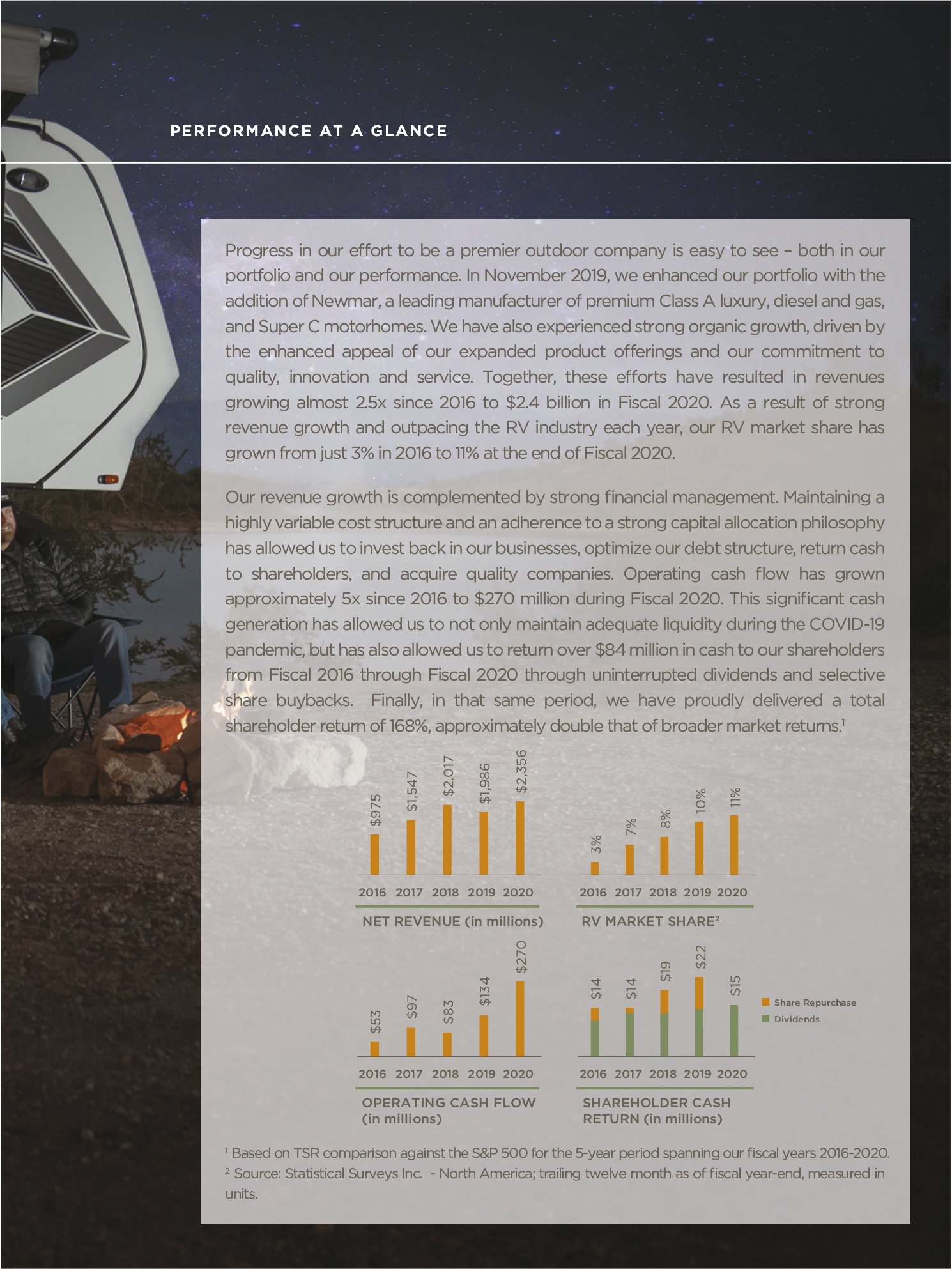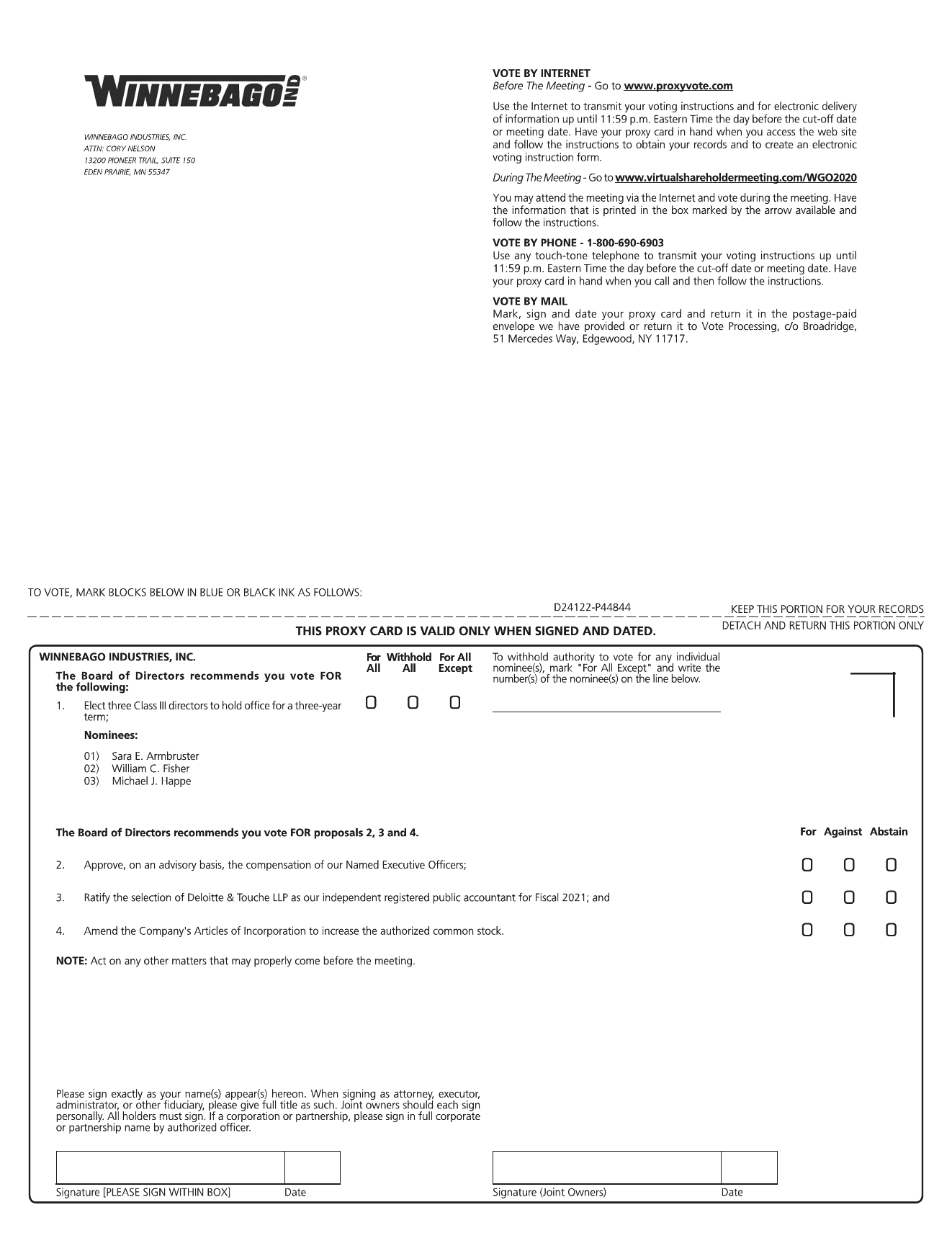Articles of Incorporation of
Winnebago Industries, Inc.
To the Secretary of State of the State of Iowa:Article I
Pursuant to Section 1006 of the Iowa Business Corporation Act, the undersigned corporation adopts the following amendment to the corporation’s articles of incorporation.NAME OF CORPORATION
1. The name of the corporationCorporation shall be “Winnebago Industries, Inc.”
Article II
CAPITAL STOCK
The total number of shares of stock which the Corporation shall have authority to issue is: one hundred thirty million (130,000,000), of which one hundred twenty million (120,000,000) shall be shares of Common Stock, $.50 par value (“Common Stock”), and ten million (10,000,000) shall be shares of Preferred Stock, $.01 par value (“Preferred Stock”).
The Board of Directors is Winnebago Industries, Inc.authorized to establish one or more series of Preferred Stock, setting forth the designation of each such series, and fixing the relative rights and preferences of each such series.
2. Article IVEach holder of record of Common Stock shall be entitled to one vote for each share of Common Stock held by such shareholder on every matter voted on at every meeting of shareholders of the Articlescorporation. No holder of Incorporationshares of Winnebago Industries, Inc.,stock of any class or series shall be entitled to cumulate his/her votes in any election of directors.
No holder of shares of stock of any class or series shall be entitled as previously amended and restated, is further amendedsuch, as a matter of right, to read and restated to read as follows:subscribe for or purchase any part of any new or additional issue of shares of stock of any class or series whatsoever or of any securities convertible into or exchangeable for any shares of stock of any class or series whatsoever, whether now or hereafter authorized or issued for cash or other consideration.
Article III
THE REGISTERED OFFICE
The address of the registered office of the Corporation shall be 13200 Pioneer Trail, Suite 150, Eden Prairie, MN 55347.
Article IV
DIRECTORS
The total number of shares of stock which the Corporation shall have authority to issue is: one hundred thirty million (130,000,000), of which one hundred twenty million (120,000,000) shall be shares of Common Stock, $.50 par value, and ten million (10,000,000) shall be shares of Preferred Stock, $.01 par value (“Series Preference Stock”).
A statement of the designations and the powers, preferences and rights of such classes of stock and the qualifications, limitations or restrictions thereof, the fixing of which by the Articles of Incorporation is desired, and the authority of the Board of Directors to fix, by resolution or resolutions, the designations and the powers, preferences and rights of such classes of stock or the qualifications, limitations or restrictions thereof, which are not fixed hereby, are as follows:
A.
| Provisions Applicable to All Series of Series Preference Stock. |
(1) Shares of Series Preference Stock may be issued from time to time in one or more series. The voting powers, designations, preferences, limitations and relative rights of each series may differ from those of any and all other series already outstanding; the terms of each series shall be specified in the resolution or resolutions hereinafter referred to; anddirectors constituting the Board of Directors of the Corporation is hereby expressly granted authorityshall be not more than fifteen (15) and not less than three (3), the precise number to fix,be determined by resolution or resolutions adopted priorof the Board of Directors from time to time.
The directors shall be classified, with respect to the issuancetime for which they severally hold office, into three classes, as nearly equal in number as possible, with each class holding office for a term of three years, and with the respective members of each class to hold office until their respective successors are elected and qualified. At each annual meeting of shareholders, the successors to the class of directors whose term then expires shall be elected to serve a three-year term and until their successors are duly elected and qualified. No decrease in the number of directors shall have the effect of shortening the term of any sharesincumbent director. Any increase or decrease in the number of a particular series of Series Preference Stock, the voting powers, designations, preferences, limitations and relative rights of each series, including, but without limiting the generality of the foregoing, the following:
(a) The rate and times at which, and the terms and conditions on which, dividends on the Series Preference Stock of such seriesdirectors shall be paid;apportioned among the classes so as to make all classes as nearly equal in number as possible.
(b) The right, if any, of holders of Series Preference Stock of such series to convert the same into, or exchange the sameShareholders may remove directors only for other classes of stock of the Corporation and the terms and conditions of such conversion or exchange;
(c) The redemption price or prices and the time at which, and the terms and conditions on which, Series Preference Stock of such series may be redeemed;cause.
















































































